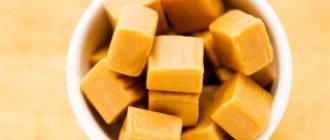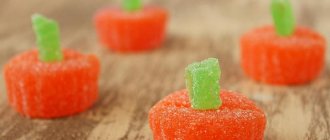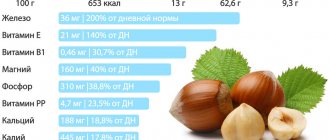What is caramel made from?
The recipe for classic caramel, which dates back to the 14th century, requires the use of only two main ingredients - water and sugar. The mixture was heated, poured into molds, and then cooled.
Modern caramels are also made from sugar, but in the production they additionally use invert syrup - a solution of sugar with citric acid, or caramel molasses. Such components help the sugar mass thicken faster. Food flavorings and dyes are added to candies, which also affect the nutritional value of the finished product.
Lollipops made with molasses contain:
- sucrose – 58%;
- glucose – 10%;
- polysaccharides (dextrin) – 20%;
- maltose – 7%;
- fructose – 3%.
The remaining 2% comes from water.
If invert sugar is used in production, then it occupies 20% of the volume, the remaining 80% is sucrose.
Caramel, whose calorie content on average reaches 360-380 kcal per 100 g, consists almost entirely of carbohydrates, the content of which fluctuates around 90 grams. There are practically no proteins or fats in the composition. The share of each nutrient in 100 g of product is insignificant - less than 1 gram.
Frequent use of lollipops is harmful to the body, as they can provoke:
- rapid weight gain;
- development of carious formations;
- provoke worsening of the condition in patients with diabetes or pancreatitis.
But caramel can also have a positive effect: consuming candy after physical activity promotes a surge of energy. This is due to the large amount of carbohydrates they contain.
Calorie content and chemical composition
Since the raw material for making caramel is sugar, the calorie content of this delicacy is very high.
On average, the energy value of 100 g of caramel is 378 kcal. As for nutrients, the product consists almost entirely of carbohydrates (92.9 g), fats 0.8 g, and proteins 1 g. Chemical composition: vitamins
| Vitamin E | 0.2 mg |
| Vitamin PP | 0.2 mg |
| Vitamin K | 1.8 mcg |
| Vitamin B12 | 0.3 mcg |
| Pantothenic acid | 0.62 mg |
| Vitamin C | 0.4 mg |
| Kholin | 8 mg |
Moreover, contrary to the popular opinion that caramel is sugar in its pure form and cannot be a source of any useful substances, in fact it has a rather impressive chemical composition, including vitamins, macro- and microelements.
Chemical composition: macro- and microelements
| Iron (Fe) | 2.8 mg |
| Phosphorus (P) | 60 mg |
| Potassium (K) | 90 mg |
| Sodium (Na) | 41 mg |
| Magnesium (Mg) | 37 mg |
| Calcium (Ca) | 31 mg |
| Zinc (Zn) | 0.44 mg |
| Fluorine (F) | 27 mcg |
| Copper (Cu) | 0.018 mg |
Calorie content of different types of caramel
The average number of calories per 100 grams of product is about 380 kcal. Based on this, the calorie content of 1 piece of caramel weighing about 6 g is 22.8 kcal. But this indicator is average: it all depends on the type of product itself.
Lollipops
The brightly colored candies, so beloved by children and adults, consist almost entirely of sugar. This causes a high carbohydrate content: 100 g of candy contains about 97.5 g. Therefore, 100 grams of candy contains a fairly large number of calories - about 390.
With liqueur
Approximately 358 calories.
It is worth remembering that the candy also contains an alcoholic component, which, when consumed in large quantities, can have a harmful effect on the body, especially when using antibiotics or following a diet.
Chocolate
If regular candies can still be consumed in small quantities without fear of instantly gaining extra pounds, then it is better to avoid candy with chocolate filling.
When chocolate is added, 8 g of fat and 1.6 g of protein per 100 g appear in the product. The increase in nutritional value is determined precisely by the addition of chocolate, the calorie content of which reaches 550 kcal per 100 g. However, its content in the filling is small, so the number of calories in the candy still does not reach the level of pure chocolate, but increases from an average of 380 kcal to 427 kcal.
Fruity
But caramel with fruit fillings is considered one of the lowest-calorie types among all similar products. Calorie content fluctuates around 372 kcal. This means that one candy weighing 6 grams contains approximately 22 kcal.
Lipstick
The calorie content of caramels with fondant filling fluctuates at 366 kcal, but the mark can drop to 358 kcal. This is due to the raw materials from which the filling is made. In the production of fudge, not only sugar is used, but also milk, which “dilutes” the carbohydrate component of the sweets. However, with its addition, other nutrients appear in caramel: fat in the amount of 4.6 g and 2.2 g of protein.
Glazed
Chocolate-coated lollipops contain about 390 kcal. However, if natural chocolate is used in the manufacture of glaze, the calorie content of the finished product increases: the figure reaches 400-420 kcal per 100 g. The use of synthetic substitutes allows the calorie content to remain approximately at the level of regular caramel, i.e. at around 380 calories.
The calorie content of caramel per 100 grams depends on the type of sweet product. If, for example, we take Rot Front products, then the calorie content of Moskvichka caramel per 100 grams will be 396 kcal. In a 100 gram serving of sweets:
- 2.6 g protein;
- 9 g fat;
- 79 g carbohydrates.
The composition of the candies includes sugar, molasses, chocolate glaze, condensed sweetened milk, alcohol, cocoa powder, flavoring, stabilizer, and milk fat substitute.
Calorie content of caramel candies in 1 piece. depends on the type of product. So, in one Moskvichka caramel:
- 43.56 kcal;
- 0.29 g protein;
- 0.99 g fat;
- 8.69 g carbohydrates.
Types of caramel
Today, there are a huge variety of types of caramel. However, all of it is divided into two main categories: hard and soft. Hard ones are usually used to make sweets, including lollipops, while soft ones are added to confectionery products or used as a food additive.
Depending on the type of syrup used during preparation, there are caramels based on maltose, sucrose and glucose.
Finally, the hard caramel from which candies are made comes in different flavors: fruit, liqueur, chocolate, berry, mint.
The benefits of caramel
The beneficial properties of caramel include:
- the product increases the level of the happiness hormone, therefore helps to cope with stress, apathy, and depression;
- After intense physical and mental stress, you can quickly restore the body's strength with the help of caramel. This is due to the saturation of sweets with calories and fast carbohydrates;
- In cosmetology and folk medicine, caramel is actively used to prepare masks. Thanks to the addition of this component, the masks make the skin even more velvety and smooth.
Harm to caramel
Of the harmful properties of caramel, it should be noted:
- sweets are saturated with sugar, which damages the integrity of tooth enamel and promotes the development of caries;
- caramel is excluded from the diet in case of diabetes, exacerbations of pancreatitis, cholecystitis;
- You will have to refuse the product if you are prone to edema, as well as with flatulence and bloating;
- due to their high calorie content and saturation with harmful carbohydrates, sweets are excluded from the diet if you are overweight, during a diet and losing weight;
- molasses and fruit acids of caramel contribute to dysfunction in the intestines;
- Some people have an individual intolerance to sweets, which can manifest itself in the form of rashes on the back, chest, and face.
Not everyone, but many sweet tooth lovers are periodically interested in how many calories are in chocolate candy. This is not surprising: most people with a sweet tooth are women who try to watch their weight.
Modern ladies do not need to know the calorie content of chocolates by heart: it is enough to have access to the Internet. The packaging usually also contains such information, but the calories there are given per 100 grams of product. If you are extremely careful about your diet, you may find information about the calorie content of a single candy useful.
Beneficial properties and harm
One of the main beneficial properties of caramel is its ability to soothe the throat in diseases of the upper respiratory tract.
Moreover, what is noteworthy is that not only special medicinal candies, which are the brainchild of pharmaceuticals, have a similar effect, but also ordinary burnt sugar, even prepared at home. When the caramel is absorbed, saliva is released, which softens the inflamed mucous membrane, as a result of which inflammation and pain go away faster.
Caramel is also an excellent remedy for hypoglycemia, in other words, a sharp decrease in blood glucose levels. A sweet treat can be used as an emergency remedy for mild forms of this pathological condition.
However, at the same time, sugar, which is the basis of this product, can cause serious harm to human health.
This delicacy should not be abused by people who are overweight and trying to get rid of extra pounds. The fact that caramel is a high-calorie product speaks for itself.
Many types of sweets contain fruit acids. Therefore, overuse of this delicacy can lead to dental problems.
Products containing molasses and fruit acids can provoke dysfunction of the intestinal environment and also contribute to the development of pathogenic microflora. This is fraught not only with manifestations of dyspepsia, such as flatulence, pain and diarrhea, but also with the appearance of a rash on the face, chest and back.
Glucose entering the body in large doses is a serious burden on the pancreas. Therefore, in case of diseases of this organ, it is better to refuse delicacies.
According to data obtained by scientists during recent studies, the information that sweets stimulate the brain and sharpen cognitive abilities is not entirely true. The thing is that subconsciously a person perceives dessert as a kind of reward for his work. Therefore, the brain seems to receive a signal: “That’s it, stop working, it’s time to rest.” That’s why you shouldn’t get too carried away with eating sweets, including caramel, trying to “stimulate” yourself before work.
Calorie determination
It's no secret that chocolates contain a lot of calories. Dark chocolate has the least amount of calories, while milk chocolate has the most calories. 100 grams of chocolates contain from 450 to 600 kcal. Fats make up 54%, carbohydrates – 36%, proteins – 10%.
The most calories are contained in milk chocolate candies with nut, waffle, cream filling, condensed milk, and halva (550–600 kcal per 100 g). Dried fruits and berries (prunes, dried apricots, etc.) in chocolate glaze (350–450 kcal) will be less nutritious; the lowest calorie chocolates are jelly, soufflé, and bird's milk (250 kcal).
Determining your norm is very easy. It is enough to read the label, which indicates the weight and energy value, divide by the number of candies and find out how many calories there will be in one piece. When making homemade candies, you can calculate the number of calories per unit based on the calorie content and weight of the products used.
Piece calorie content of popular chocolates
Candy calorie table
| Candies | Proteins, g | Fats, g | Carbohydrates, g | Kcal per 100 g |
| Barberry | 96 | 370 | ||
| Bars | 11 | 30 | 53 | 514 |
| Squirrel | 9 | 33 | 53 | 538 |
| Cornflowers | 3 | 13 | 74 | 412 |
| Inspiration | 6 | 34 | 55 | 541 |
| evening call, evening Bell | 11 | 34 | 49 | 542 |
| Chocolate covered roast | 5 | 27 | 65 | 509 |
| Crow's feet | 2 | 7 | 88 | 409 |
| Duchess | 96 | 373 | ||
| Golden domes | 6 | 31 | 56 | 519 |
| Iris "Golden Key" | 3 | 8 | 82 | 395 |
| Iris "Kit-kis" | 3 | 12 | 77 | 416 |
| Lemon caramel | 94 | 362 | ||
| Mint caramel | 97 | 365 | ||
| Fruit and berry caramel | 93 | 360 | ||
| Strawberries and cream | 1 | 1 | 92 | 362 |
| Cranberries in sugar | 1 | 96 | 384 | |
| Cow | 6 | 33 | 55 | 541 |
| Little Red Riding Hood | 7 | 29 | 58 | 515 |
| Dried apricots in chocolate | 5 | 16 | 56 | 386 |
| Martin | 3 | 10 | 77 | 398 |
| Lollipops | 97 | 389 | ||
| Mask | 9 | 31 | 54 | 523 |
| Dream | 94 | 364 | ||
| Teddy Bear | 6 | 31 | 59 | 529 |
| Bear in the north | 8 | 32 | 55 | 529 |
| Muscovite | 3 | 9 | 79 | 394 |
| Autumn Waltz | 11 | 34 | 49 | 537 |
| Cockerel - golden comb | 7 | 36 | 57 | 530 |
| Cancerous cervixes | 2 | 8 | 87 | 411 |
| Raffaello | 9 | 48 | 37 | 615 |
| Daisies | 3 | 14 | 74 | 419 |
| Soufflé in chocolate | 2 | 18 | 58 | 406 |
| Truffle | 5 | 35 | 55 | 548 |
| Halva in chocolate | 15 | 33 | 44 | 528 |
| Citron | 1 | 18 | 82 | 389 |
| Prunes in chocolate | 5 | 20 | 50 | 390 |
Historical excursion
Chocolate appeared about 150 years ago. It was consumed as a drink, then as a medicine. With the help of cocoa beans, people were treated for anemia, loss of strength, and even tuberculosis.
The further history of this confectionery product began to accelerate every year. The product has become of higher quality and diversified, new tastes and aromas have appeared, and entire generations of chocolatiers have been formed. Each of them contributed to the improvement of this product. Today everyone knows the most worthy companies and well-known manufacturers. These include Belgian, Swiss, French manufacturers. Our country also has its own veterans. Among them are “Babaev Factory”, “Red October”, “Rot Front”, etc.
How can you spend the calories received after eating chocolate candy (approximate data)
Production Features
The raw material for making the delicacy is the ripened fruits of the cocoa tree, which grows in America, Indonesia and Australia. They are removed, sorted, fried, crushed and sent into powder form for chocolate production. Oil is also extracted from cocoa beans by pressing.
When making chocolates, powder, powdered sugar and cocoa butter are used. For a milky look, add milk or cream. The raw material, brought to a homogeneous consistency, is poured into special molds and the filling is added. All that remains is to put the candies in boxes or wrap them in colored wrappers.
You can prepare the treats yourself. To do this you will need cocoa powder, sugar, flour, milk, cocoa butter or butter and a filling of your choice. In this case, you will also know how many calories are in the candy.
To eat or not to eat?
Chocolate products can be beneficial when consumed in moderation. Thus, the famous long-living Frenchwoman Jeanne Calment was very fond of this confectionery product. Many vitamins, microelements, and beneficial amino acids allow the body to fight depression, improve mood, and strengthen memory.
The joy hormone serotonin, produced by the body when eating chocolate, allows a person to escape from the hustle and bustle and problems. Children should also be periodically pampered with sweets, since pleasure is especially important in childhood.
The dangers of chocolate can only be discussed in terms of the amount of sweets consumed, which must be controlled. You should also pay attention to candies with alcohol, which are contraindicated for children, pregnant and lactating women. Drivers are also advised to be careful with this dessert.
If you are one of those with a sweet tooth who is very worried about their figure, but cannot refuse chocolates, you have one reasonable way out of the situation: burn calories with physical activity. To do this, just go for a walk some time after drinking tea (or, if you live on the ninth floor, check your mailbox without using the elevator).
Do you like candy? - Fine. Curious about their calorie content? - Amazing! This means that sweets will only be a useful product for you because you decided to control their quantity.
If you are specifically interested in the calorie content of candy, then you should understand that different candies have completely different calorie content. It all depends not only on what material the candy is made of (chocolate, toffee, lollipop, icicle), but also what filling the candy has. In view of this, we simply cannot physically list for you the calorie content of all existing candies, because they all differ in some way - composition, weight, filling, so we will give you only examples of the most common candies, indicating the approximate weight and their calorie content.
Data per 100 grams of candy product.
Therefore, make a basic calculation based on the weight of 1 (one) candy. Weight is indicated in each section. Do you want to lose weight? - Count your calories.
Candy type prunes in chocolate
(Weighing from twenty-five to eighty-five grams).
Has a caloric content of 343 (three hundred and forty-three) kilocalories.
Candy "Golden Step"
(It also comes in different weights - from twenty to ninety-two grams).
The calorie content of one hundred grams of such sweets is 488 (four hundred eighty-eight) kilocalories.
Candy "Grand Tofi"
(It can weigh from seven to thirty-one grams).
Calorie content is 452 (four hundred fifty-two) kilocalories.
Candies "Squirrel"
(They weigh from eleven to fifty-eight grams).
Calorie content – 531 (five hundred thirty-one) kilocalories.
Candy "Spark"
(The weight of Spark candy with prunes ranges from twenty-five to ninety-seven).
Calorie content – 389 (three hundred eighty-nine) kilocalories.
"Bird's Sweetness"
(The weight of Bird Sweet candies ranges from seventeen to seventy-two grams).
Calorie content – 424 (four hundred twenty-four) kilocalories.
"Martin"
(“Swallow” ranges from fifteen to sixty grams).
The calorie content of this candy is 400 (four hundred) kilocalories.
"Levushka"
Levushka is about the same weight - 386 (three hundred eighty-six) kilocalories.
Fruit caramel – “Icicle”
As for fruit caramel, which is most often popularly called “Icicle”, their calorie content is not too high (of course, relative to all sucking candies).
For one hundred grams of candy - 300 (three hundred) kilocalories.
And if you buy those that do not contain sugar, the calorie content is even lower. Especially such lollipops can be found in the pharmacy.
Let's figure out what the calorie content of sweets is
Most people with a strong sweet tooth cannot imagine their life without such a delicacy as candy.Indeed, it is very difficult to resist the temptation to indulge in sweets when you see just a gigantic assortment of caramels, candies and chocolate products offered in literally every store.
Moreover, the candies have a rich assortment of different tastes, and the bright design attracts the eye and makes you want to immediately purchase and eat this luxury!
Calorie content, or energy value, is the amount of energy released in the human body during the digestion process. So it turns out that you have to pay for consuming excess calories by spending a lot of effort and energy on the gym or doing physical exercises.
So that you do not have to torture yourself with constant training, carefully study the table of calorie content of sweets, then you will be able to most accurately determine for yourself how much of them you are “allowed”!
Name of sweets
| Their calorie content is 100 g. | |
| Lollipops Dirol | 67 |
| Jelly marmalade | 160 |
| Candy caramel | 241 |
| Marmalade | 286 |
| Marmalade “Juicy Berry” | 305 |
| Marmalade Udarnitsa | 320 |
| Truffle | 345 |
| Iris | 355 |
| Milk candies Korovka | 364 |
| candy fudge | 369 |
| Chupa Chups | 369 |
| Caramel with filling | 378 |
| Mars | 380 |
| Levushka | 386 |
| Souffle | 397 |
| Cherry covered in chocolate | 399 |
| Toffee Meller with chocolate | 410 |
| Ruzanna | 414 |
| Peanuts in chocolate | 430 |
| Marmalade in chocolate | 436 |
| Chocolate with filling | 450 |
| Farce with crispy waffle balls | 452 |
| Elite in milk chocolate | 469 |
| Cherries in rum and chocolate | 470 |
| Grapes in white wine and chocolate | 480 |
| Snickers | 480 |
| Elite in dark chocolate | 482 |
| Cherries in liqueur and chocolate | 490 |
| Twix | 498 |
| Pineapple | 501 |
| Resort | 502 |
| Grilyazh | 510 |
| Kara godfather | 511 |
| Cockerel | 512 |
| Dark chocolate Alpen Gold Orange | 516 |
| Bylina Nikitich | 516 |
| Squirrel | 518 |
| Roth Front bars | 518 |
| Chocolate Alpen Gold yellow | 518 |
| Silver hoof | 519 |
| Curious chocolate candies | 520 |
| Wonderful evening | 521 |
| Cedar | 522 |
| Chocolate Dream with waffles | 523 |
| Ritter Sport milk chocolate with hazelnuts, rum and raisins | 524 |
| Mouth Front Mask | 526 |
| Halva in chocolate | 528 |
| Wafers in milk chocolate Kit-kat | 530 |
| Desert Caravan | 532 |
| Blizzard | 532 |
| Chocolate Alenka | 538 |
| Assorted dark chocolate | 539 |
| Chime in waffle crumbs | 543 |
| Assorted Korkunov | 544 |
| Sonata (Victory) | 544 |
| Milk chocolate with nuts | 544 |
| Chocolate 75% Babaevo | 544 |
| Lollipops | 545 |
| Milka milk chocolate with hazelnuts | 546 |
| Milk chocolate | 550 |
| Assorted Korkunov | 551 |
| Chocolate “Inspiration” with truffle cream and almonds | 553 |
| Bitter chocolate | 554 |
| Kinder chocolate | 554 |
| Ritter Sport dark chocolate with whole hazelnuts | 559 |
| Kinder country | 559 |
| Red poppy | 560 |
| Chocolate Geisha | 560 |
| Ritter Sport milk chocolate with whole hazelnuts | 565 |
| Esfero | 570 |
| Chocolate white | 578 |
| Ferrero Rocher | 579 |
| Teddy bear in the forest | 580 |
| FERRERO Rocher | 580 |
| Truffle Victory | 580 |
| Come il faut | 585 |
| Prunes in chocolate | 612 |
| Raffaello | 615 |
Having studied in detail the table of caloric content of such desirable and delicious sweets, you will no longer be afraid that you will accidentally exceed the permissible calorie limit! So have fun losing weight!
There are no people in the world who don’t love candy!
Sweets are an integral and very important part of our life.
Sweets have an amazing ability to relieve bad mood.
Scientists have also proven that sweets act on the body as an antidepressant.
It is not surprising that in the most difficult moments of her life a woman is ready to throw herself on cakes, ice cream, and chocolates.
The fact is that after eating these sweets our souls actually feel a little lighter.
True, then all these sweets are deposited on the sides, stomach and thighs, the most problematic areas. And despite the fact that sweets, especially chocolate, contain a substance that helps the formation of the joy hormone in our body, after eating sweets we can become depressed again when we see how harmful it is to our body. And this can simply cause a vicious circle - we kill depression with sweet foods, and sweet foods are stored as fat in our body, which then causes depression in us.
However, there is one “But”
In addition to the fact that sweets are not a very healthy product for teeth, because they affect the formation of caries, they are also the number one enemy in the fight against excess weight. That is why most existing methods for losing weight completely exclude the use of such sweets from their nutritional diet. However, if you try really hard, you can find some diets that allow a small amount of sweets. However, most often these diets are based on counting the calories consumed daily.
Today you can easily find a calorie table on the Internet. Actually, most sites focused on dietary topics and weight loss topics can offer you so-called calorie calculators or weight loss counters.
Attention! Candy and a woman's age!
The fact is that the amount of calories consumed (the optimal amount) will be different for each age!
From 18 to 20 years old
If you are in the age group of eighteen to twenty-nine years, then you can consume about 2200 (two thousand two hundred) calories per day.
From 30 to 50 years
If your age is from thirty to fifty-nine, then the amount of calories allowed for you should not be more than 2000 (two thousand) kilocalories per day.
Over 60 years
Women over sixty should not eat more than 1800 (thousand eight hundred) calories daily.
How to choose quality caramel
To choose a truly high-quality product that will not only be tasty, but also healthy, you should consider several factors.
First of all, soft caramel is considered less harmful compared to the so-called candy. During its preparation, the sugar mass is stretched, as a result of which it is saturated with oxygen. It is also less harmful to tooth enamel.
Pay attention to the color. Refrain from purchasing too bright, “acid” shades of the product. Unnatural colors indicate that dyes were used in the preparation, which will not bring any health benefits. It is better to choose caramel in natural shades: golden, cream or coffee.
The filling is of great importance. Thus, the safest candies are filled with fruit puree or jam, as well as chocolate, nuts or marzipan. But milk filling is not the best option. The thing is that for its production, refractory fat is used, which can only be digested at temperatures above sixty degrees Celsius. Therefore, our body, whose temperature ranges from 36 to 37 degrees, simply cannot cope with it. You should also approach lollipops with a “refreshing” effect with caution, unless it is a medical medicinal caramel intended for a sore throat. Conventional sweets most often use not natural, but chemical menthol, which can cause an allergic reaction.
The shelf life of natural caramel is very short. If the surface of the candy is sticky or damp, it means that it is running out and it is better to refrain from purchasing such a delicacy.
Diets vs candy!
As we have already said, most modern dietary methods for losing weight categorically prohibit the consumption of any sweets, we are not even talking about chocolate or sucking candies.
However, it is all the more difficult for us to fight this because when we come to the store, it becomes especially difficult for us, because in the markets there is such a huge variety of these sweets (both in appearance and in their content) that it is so difficult to restrain ourselves within limits!
It's hard to live without sweets!
It is especially difficult if you have already chosen your favorite type of candy and are constantly forced to contemplate it on store shelves at a time when you have just started following a certain diet.
Although it is worth noting that there are still diets during which you can occasionally make small deviations from the classic scenario and eat just a little sweets, however, even here you will have to take into account how many calories you have eaten and how much you can still eat.
So, you can’t live without sweets, but how passionate do you want to lose weight?
There is nothing wrong. Just divide your nutritious diet into parts, carefully count all the calories so as not to fall behind the schedule, and then simply replace some product with the required amount of candy.
So you can easily combine your favorite treat with dietary nutrition.
4.7 out of 5
Ah, sweets, beloved and desired since childhood! There are probably few people who would say with a clear conscience that they don’t like candy. And those who are on a diet and limit themselves in everything, and especially in sweets, sometimes simply break down. But is it necessary to mock yourself like that? It is enough to find out how many calories are in the candy and enter it into the menu, reducing the number of other dishes. It’s better to eat them little by little all the time than to eat half a kilo at a time.
Many people cannot imagine how they can live without sweets, and it is unimaginably difficult for them to resist the temptation. It is especially difficult to restrain yourself in a store where an incredibly tasty assortment is presented. The candies are so varied in taste that you really want to pamper yourself with them!
Unfortunately, even the calorie content of 1 candy is not small at all, so for people who are counting calories and are in the process of losing weight, it is very important not to get carried away. But you should still have fun losing weight! You can eat this sweet occasionally - but in moderation, maintaining balance, being aware of the effect of different sweets on our body. For example, if the calorie content of cow candy and the calorie content of bird's milk candy are approximately the same, then the calories in chocolate candy are much higher.
The benefits and harms of sweets
When talking about the benefits of sweets, it is worth understanding that the positive effect of these sweets will come to naught if you abuse them or eat them in large quantities.
Naturally, the most obvious positive property of sweets (no matter whether they are chocolate or just candy) is their fight against seasonal depression or simply bad mood.
The benefits of chocolate candies are determined by its antiseptic effect. That is, by consuming natural chocolates consisting exclusively of dark chocolate, our body will be easier to cope with inflammatory processes and various infections.
Sweets contain a high content of carbohydrates, which gives us strength and good health for the whole day. But there is also a negative side to such a saturated carbohydrate content, this is a negative effect on weight. Namely, high calorie content provokes the development of obesity or excess weight gain.
It’s true that almost every one of us heard in childhood from adults advice not to eat a lot of sweets, otherwise your teeth will deteriorate. There is truth in this; most candies can cause tooth decay. Chewing candies and lollipops have a particularly harmful effect on teeth.
Chocolate bars can be addictive, and the prohibitive calorie content in this product, if consumed frequently, can lead not only to excess weight, but also to gastritis.
If the candy is brightly colored, it means it contains artificial dyes, which can cause allergies and other diseases associated with the gastrointestinal tract.
Not everyone, but many sweet tooth lovers are periodically interested in how many calories are in chocolate candy. This is not surprising: most people with a sweet tooth are women who try to watch their weight.
Modern ladies do not need to know the calorie content of chocolates by heart: it is enough to have access to the Internet. The packaging usually also contains such information, but the calories there are given per 100 grams of product. If you are extremely careful about your diet, you may find information about the calorie content of a single candy useful.
Various candies: calorie content
Let us remind you that the calorie content or energy value of a product is the amount of energy that is released in our body during the digestion process. Therefore, to burn extra calories, you need to expend more energy by doing physical activity. Or avoid excess calories in the body, for which there are calorie tables.
As already mentioned, the calorie content of sweets is high.
So, in Dirol candies there are 67 kcal, and in marmalade there are already 160 (per 100 g). Raffaello is very high in calories - as much as 615 kcal.
However, when counting the number of calories, it is more convenient to focus on the calorie content of 1 candy.
So, the calorie content of bird's milk candy is 444 kcal per 100 g, 53 kcal in 1 piece. The calorie content of cow candy is 364 kcal in 100 g, and 52 kcal in 1 piece.
Calories in chocolate candy (with cream filling) - approximately 523 per 100 g, almost 100 kcal in one piece
.
As for other sweets and candies, their calorie content can also be calculated individually:
- Raffaello 62 kcal;
- USSR ice cream 215 kcal;
- Teddy bear 80 kcal;
- Fruge with prunes 56 kcal;
- Meller (iris) 14 kcal;
- Skittles (dragée) 5 kcal;
- M&M's 3.33 kcal;
- Chupa Chups (candy) 57 kcal;
- Orbit without sugar (watermelon lollipop) 6 kcal;
- Kara-Kum 74.51 kcal;
- large Snickers (95g) 502 kcal;
- small Snickers (55g) 280 kcal;
- large Sars (73g) 331 kcal;
- large Picnic with walnuts (55 g) 261 kcal;
- small Milky Way (26 g) 118 kcal;
- large Nesquik (45 g) 219 kcal;
- small Nesquik (28 g) 140 kcal;
- grilled meat 60 kcal;
- Fruit and Nut chocolate bar with hazelnuts (90g) 500kcal, 1 slice (3.75g) 20.8kcal.
Calorie content of Candies, caramel. Chemical composition and nutritional value.
Nutritional value and chemical composition of “Sweets, caramel”.
The table shows the nutritional content (calories, proteins, fats, carbohydrates, vitamins and minerals) per 100 grams of edible portion.
| Nutrient | Quantity | Norm** | % of the norm in 100 g | % of the norm in 100 kcal | 100% normal |
| Calorie content | 382 kcal | 1684 kcal | 22.7% | 5.9% | 441 g |
| Squirrels | 4.6 g | 76 g | 6.1% | 1.6% | 1652 g |
| Fats | 8.1 g | 56 g | 14.5% | 3.8% | 691 g |
| Carbohydrates | 77 g | 219 g | 35.2% | 9.2% | 284 g |
| Water | 8.5 g | 2273 g | 0.4% | 0.1% | 26741 g |
| Ash | 1.8 g | ~ | |||
| Vitamins | |||||
| Vitamin A, RE | 12 mcg | 900 mcg | 1.3% | 0.3% | 7500 g |
| Retinol | 0.011 mg | ~ | |||
| beta carotene | 0.002 mg | 5 mg | 250000 g | ||
| Vitamin B1, thiamine | 0.103 mg | 1.5 mg | 6.9% | 1.8% | 1456 g |
| Vitamin B2, riboflavin | 0.256 mg | 1.8 mg | 14.2% | 3.7% | 703 g |
| Vitamin B4, choline | 8 mg | 500 mg | 1.6% | 0.4% | 6250 g |
| Vitamin B5, pantothenic | 0.62 mg | 5 mg | 12.4% | 3.2% | 806 g |
| Vitamin B6, pyridoxine | 0.056 mg | 2 mg | 2.8% | 0.7% | 3571 g |
| Vitamin B9, folates | 4 mcg | 400 mcg | 1% | 0.3% | 10000 g |
| Vitamin B12, cobalamin | 0.3 mcg | 3 mcg | 10% | 2.6% | 1000 g |
| Vitamin C, ascorbic acid | 0.4 mg | 90 mg | 0.4% | 0.1% | 22500 g |
| Vitamin E, alpha tocopherol, TE | 0.46 mg | 15 mg | 3.1% | 0.8% | 3261 g |
| Vitamin K, phylloquinone | 1.8 mcg | 120 mcg | 1.5% | 0.4% | 6667 g |
| Vitamin RR, NE | 0.148 mg | 20 mg | 0.7% | 0.2% | 13514 g |
| Macronutrients | |||||
| Potassium, K | 214 mg | 2500 mg | 8.6% | 2.3% | 1168 g |
| Calcium, Ca | 138 mg | 1000 mg | 13.8% | 3.6% | 725 g |
| Magnesium, Mg | 17 mg | 400 mg | 4.3% | 1.1% | 2353 g |
| Sodium, Na | 245 mg | 1300 mg | 18.8% | 4.9% | 531 g |
| Sera, S | 46 mg | 1000 mg | 4.6% | 1.2% | 2174 g |
| Phosphorus, P | 114 mg | 800 mg | 14.3% | 3.7% | 702 g |
| Microelements | |||||
| Iron, Fe | 0.14 mg | 18 mg | 0.8% | 0.2% | 12857 g |
| Manganese, Mn | 0.011 mg | 2 mg | 0.6% | 0.2% | 18182 g |
| Copper, Cu | 18 mcg | 1000 mcg | 1.8% | 0.5% | 5556 g |
| Selenium, Se | 1.8 mcg | 55 mcg | 3.3% | 0.9% | 3056 g |
| Fluorine, F | 27 mcg | 4000 mcg | 0.7% | 0.2% | 14815 g |
| Zinc, Zn | 0.44 mg | 12 mg | 3.7% | 1% | 2727 g |
| Digestible carbohydrates | |||||
| Mono- and disaccharides (sugars) | 65.5 g | max 100 g | |||
| Essential amino acids | |||||
| Arginine* | 0.155 g | ~ | |||
| Valin | 0.285 g | ~ | |||
| Histidine* | 0.115 g | ~ | |||
| Isoleucine | 0.258 g | ~ | |||
| Leucine | 0.417 g | ~ | |||
| Lysine | 0.338 g | ~ | |||
| Methionine | 0.107 g | ~ | |||
| Threonine | 0.192 g | ~ | |||
| Tryptophan | 0.06 g | ~ | |||
| Phenylalanine | 0.205 g | ~ | |||
| Nonessential amino acids | |||||
| Alanin | 0.147 g | ~ | |||
| Aspartic acid | 0.323 g | ~ | |||
| Glycine | 0.091 g | ~ | |||
| Glutamic acid | 0.892 g | ~ | |||
| Proline | 0.412 g | ~ | |||
| Serin | 0.232 g | ~ | |||
| Tyrosine | 0.205 g | ~ | |||
| Cysteine | 0.039 g | ~ | |||
| Sterols (sterols) | |||||
| Cholesterol | 7 mg | max 300 mg | |||
| Saturated fatty acids | |||||
| Saturated fatty acids | 2.476 g | max 18.7 g | |||
| 4:0 Oil | 0.047 g | ~ | |||
| 6:0 Kapronovaya | 0.012 g | ~ | |||
| 8:0 Caprylic | 0.013 g | ~ | |||
| 10:0 Kaprinovaya | 0.026 g | ~ | |||
| 12:0 Lauric | 0.016 g | ~ | |||
| 14:0 Miristinovaya | 0.19 g | ~ | |||
| 16:0 Palmitinaya | 1.88 g | ~ | |||
| 18:0 Stearic | 0.293 g | ~ | |||
| Monounsaturated fatty acids | 1.542 g | min 16.8 g | 9.2% | 2.4% | |
| 16:1 Palmitoleic | 0.095 g | ~ | |||
| 18:1 Oleic (omega-9) | 1.447 g | ~ | |||
| Polyunsaturated fatty acids | 3.478 g | from 11.2 to 20.6 g | 31.1% | 8.1% | |
| 18:2 Linolevaya | 3.447 g | ~ | |||
| 18:3 Linolenic | 0.025 g | ~ | |||
| 20:4 Arachidonic | 0.007 g | ~ | |||
| Omega-3 fatty acids | 0.025 g | from 0.9 to 3.7 g | 2.8% | 0.7% | |
| Omega-6 fatty acids | 3.454 g | from 4.7 to 16.8 g | 73.5% | 19.2% |
The energy value of candy and caramel is 382 kcal.
- piece = 10.1 g (38.6 kcal)
- package (2.5 oz) = 71 g (271.2 kcal)
Primary source: USDA National Nutrient Database for Standard Reference. Read more.
** This table shows the average levels of vitamins and minerals for an adult. If you want to know the norms taking into account your gender, age and other factors, then use the “My Healthy Diet” application.
Calorie content of cakes
Speaking about the calorie content of sweets, it is difficult not to mention the calorie content of equally favorite cakes, as well as cookies.
- Maria (cookies) 48 kcal;
- For coffee (cookies) 43 kcal;
- Kontik (cookies) 112 kcal;
- Muff with cream (cake) 145 kcal;
- Basket with protein cream (cake) 212 kcal;
- marshmallows made from two halves 135 kcal;
- 1 half of chocolate covered marshmallows 145 kcal;
- jelly bar in chocolate 88.8 kcal;
- dark cracker Veronica (5 pieces 10 g) 47.8 kcal;
- Nicole (cookies) 48.3 kcal;
- Nut (cookies) 118.72 kcal;
- Anniversary traditional (cookies) 55.56 kcal;
- Anthill (cake) 298.9 kcal.
As can be seen from the given values of the calorie content of sweets and cakes, even a small piece has a high energy value, not to mention the significant content of fat and harmful carbohydrates. Therefore, everyone who cares about their figure and is counting calories consumed per day should be very strict about the desire to indulge in sweets and not allow the norm to be exaggerated.
Popular articles
Losing weight cannot be a quick process. The main mistake of most people losing weight is that they want to get amazing results in a few days on a starvation diet. But it didn’t take a few days to gain weight! Extra pounds...
Properties of caramel
Nutritional value and composition | Vitamins | Minerals
How much does caramel cost (average price for 1 kg)?
Moscow and Moscow region.
150 rub.
A well-known delicacy and confectionery product, caramel has been known to people since ancient times. Modern caramel got its name from the French word caramel, which in turn was borrowed from the Latin language. It is not for nothing that the Latin word Cannamella or sugar cane underlies the name of caramel.
The thing is that the first ancient caramel began to be produced on the territory of modern India. In those distant times, Dalits or the people of Ancient India roasted sugarcane trunks directly on an open fire. Natural caramel enjoyed deserved popularity.
However, caramel in its modern form appeared much later, when medieval cooks began experimenting with sugar. In medieval Europe, sugar was a fairly expensive product that only the king and his entourage could afford. Therefore, the first caramel began to be used to decorate royal receptions, balls or feasts.











